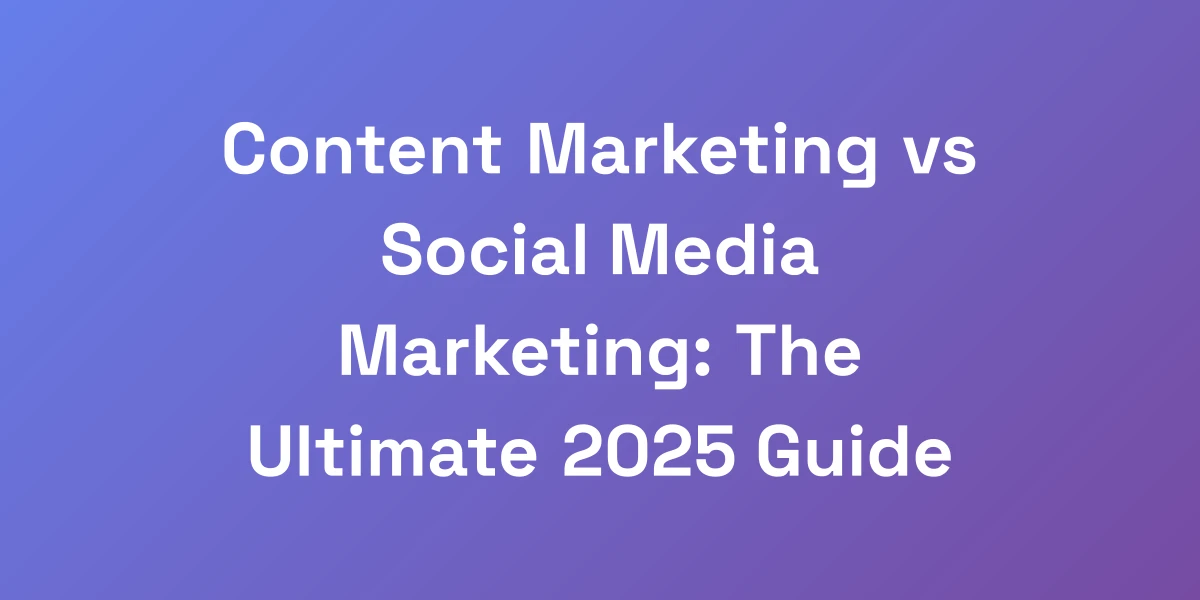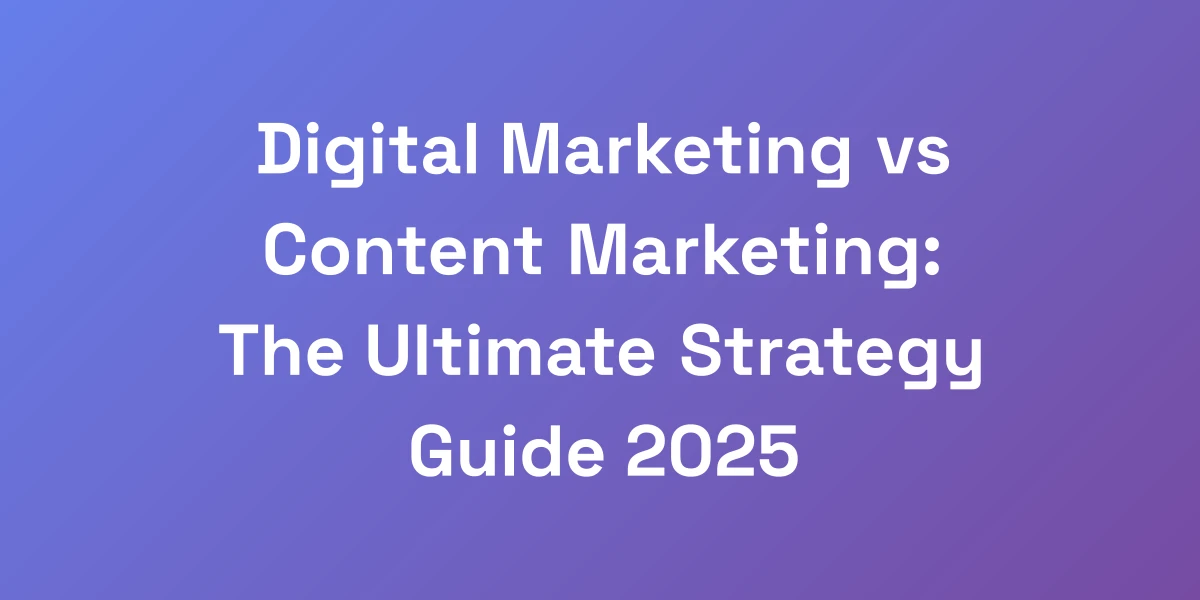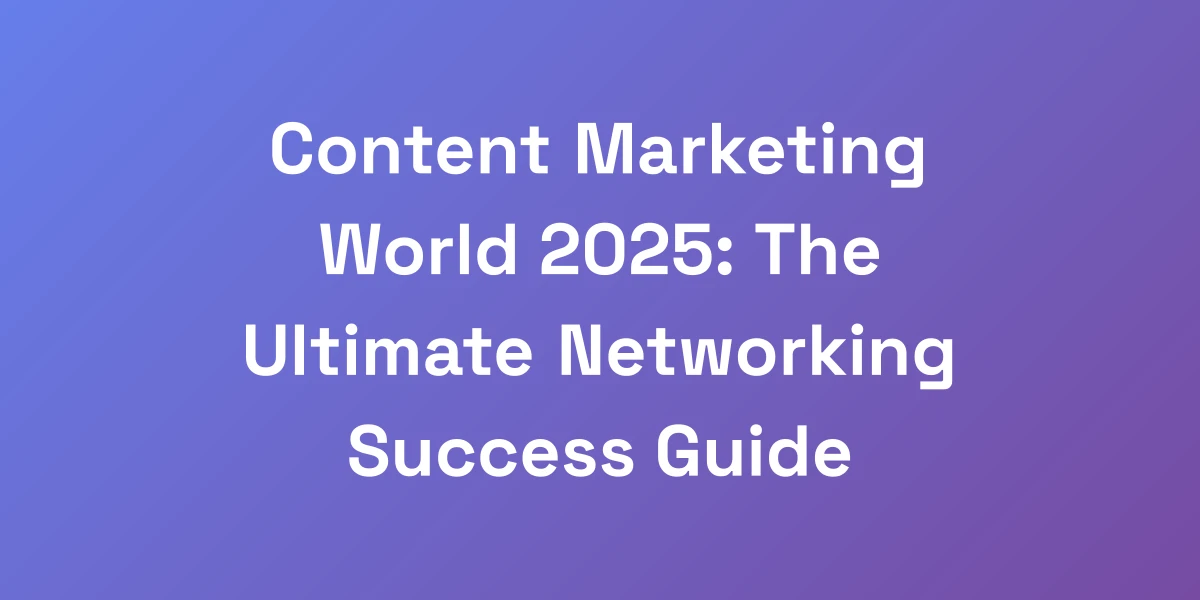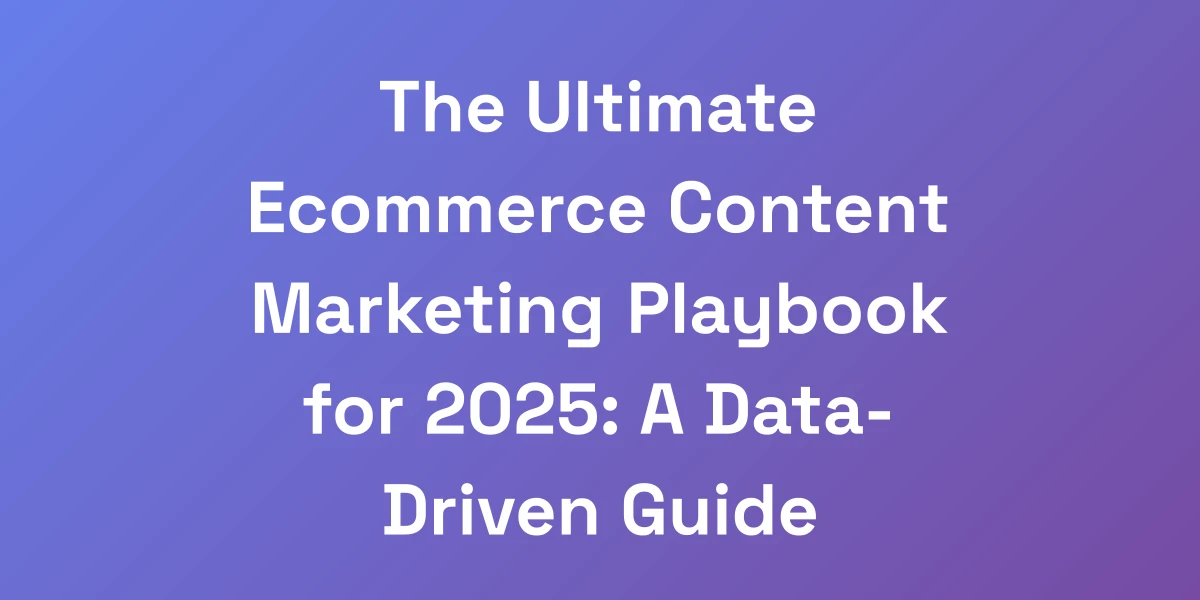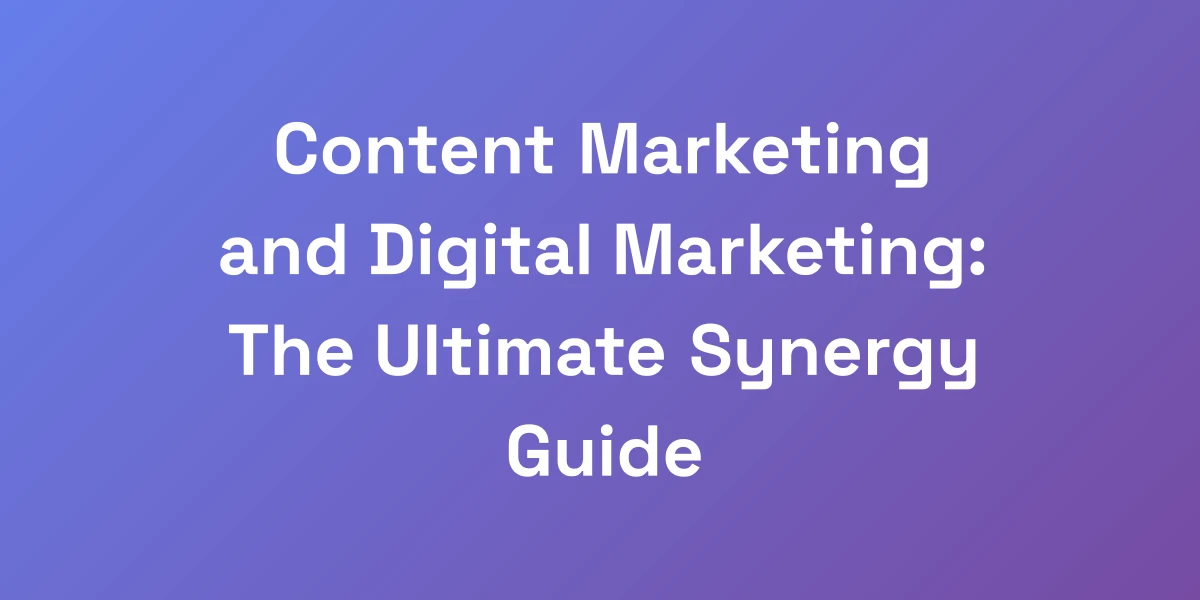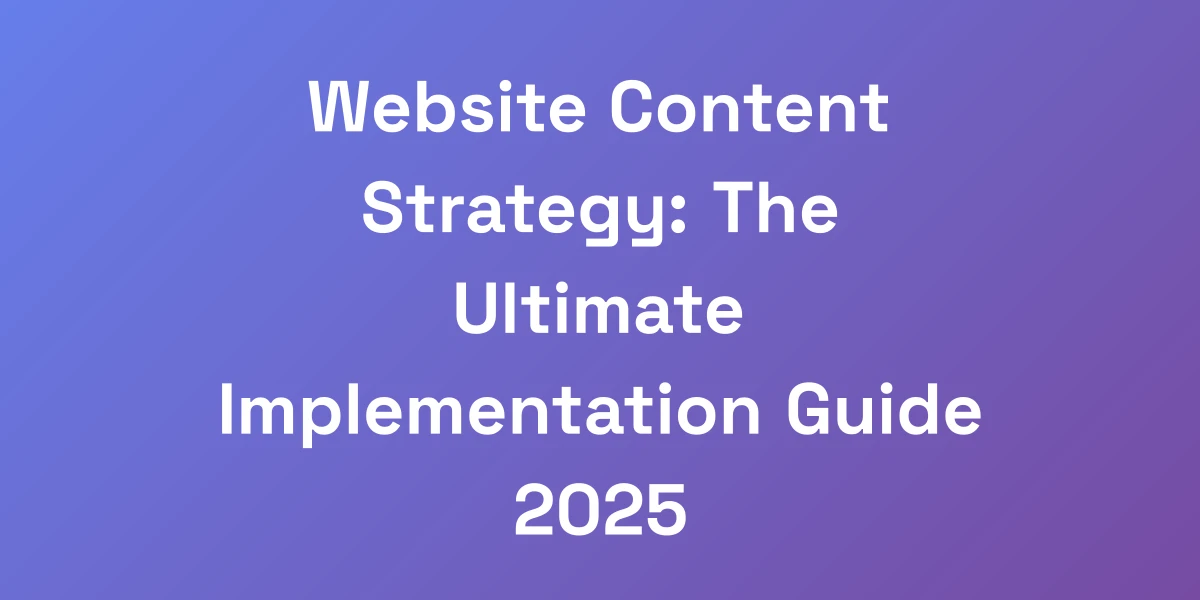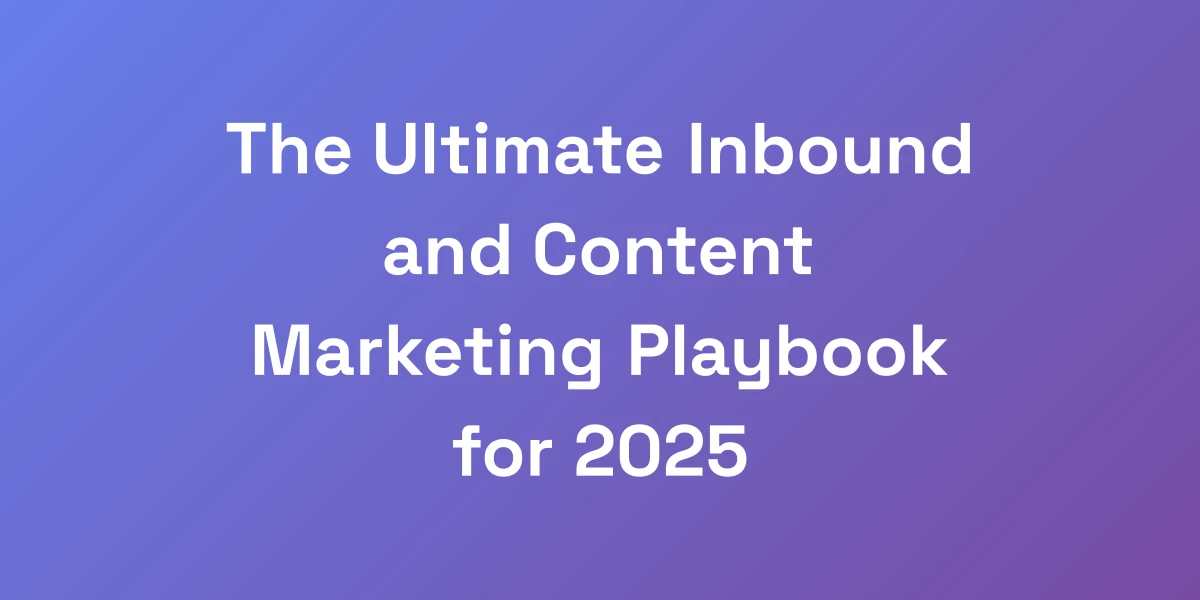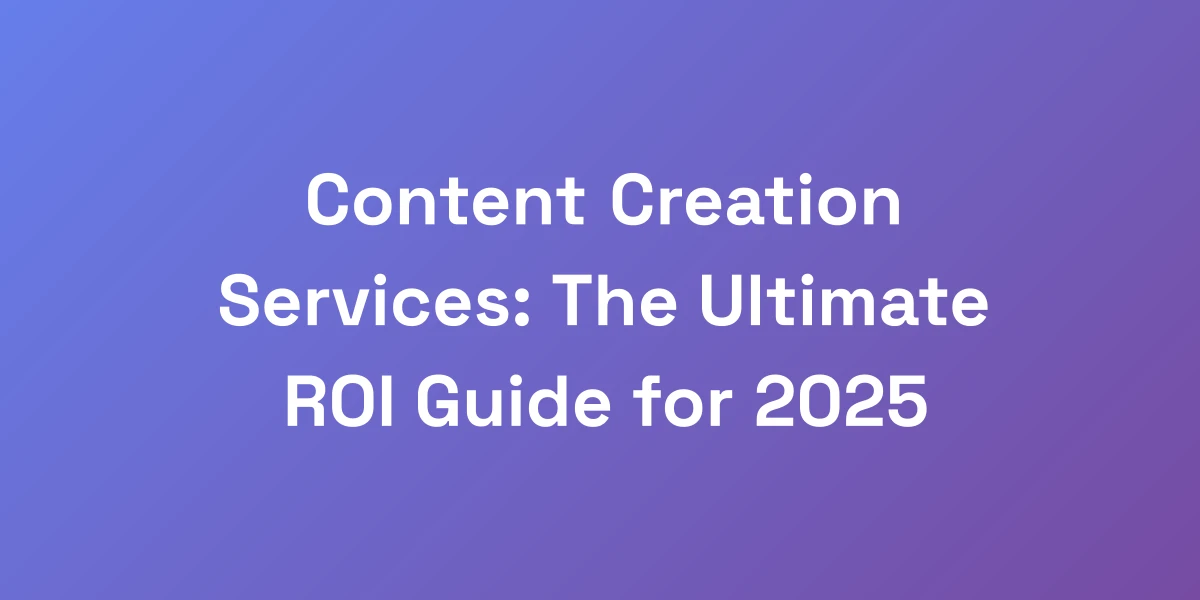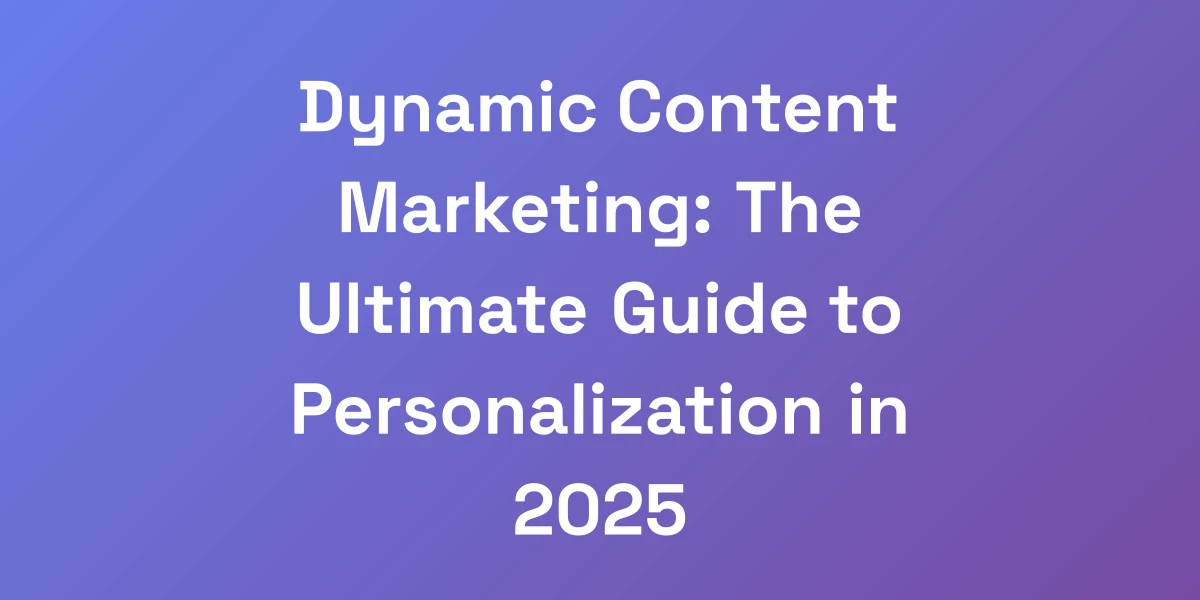
Dynamic Content Marketing: The Ultimate Guide to Personalization in 2025
Feb 24, 2025 | By [email protected]
Dynamic Content Marketing: The Ultimate Guide to Personalization in 2025
Imagine a world where every piece of content you encounter feels tailor-made just for you. Whether you’re scrolling through your favorite website, reading an email, or engaging on social media, the experience is uniquely yours. Sounds like a marketer’s dream, right? Well, welcome to the future of dynamic content marketing.
As we edge closer to 2025, personalization isn’t just a buzzword—it’s a necessity. Businesses are grappling with the challenge of standing out in a crowded digital space, and the solution lies in delivering personalized experiences at scale. We’ve all faced the frustration of generic ads and irrelevant content. So, how can we shift the narrative and create meaningful connections with our audience?
In this guide, we’ll explore the transformative power of dynamic content marketing. We’ll delve deep into its evolution, the key components that make it successful, and how emerging technologies like AI and SEO are reshaping the landscape. Ready to revolutionize your marketing strategy? Let’s embark on this journey together.
Understanding the Power of Dynamic Content Marketing in Today’s Digital Landscape
The Evolution of Content Personalization
Content personalization has come a long way since the early days of one-size-fits-all marketing. Initially, personalization was limited to addressing customers by their first names in emails. Fast forward to today, and it’s all about delivering tailored experiences based on user behavior, preferences, and data.
We’ve transitioned from static content to dynamic content that adapts in real-time. This shift is driven by the increasing availability of data and advancements in technology. Companies now recognize that personalized content not only enhances user experience but also significantly boosts engagement and conversion rates.
For instance, Netflix’s recommendation algorithm is a masterclass in content personalization. By analyzing viewing habits and preferences, Netflix delivers customized suggestions that keep users hooked. This level of personalization has set a high bar for other businesses striving to create similar experiences.
Key Components of Dynamic Content
Dynamic content marketing isn’t just about personalization; it’s an ecosystem composed of several key components working in harmony. Let’s break them down:
- Data Collection: The foundation of dynamic content lies in data. Collecting and analyzing user data enables marketers to understand their audience’s preferences and behaviors.
- Content Management System (CMS): A robust CMS is essential for managing and delivering dynamic content. It allows for real-time updates and seamless integration with other tools.
- Automation Tools: Automation streamlines the process of content delivery, ensuring that the right content reaches the right audience at the right time.
- AI and Machine Learning: These technologies analyze data trends and predict user behavior, facilitating more accurate and effective personalization.
- User Segmentation: Dividing the audience into segments based on specific criteria allows for more targeted and relevant content delivery.
Understanding these components is crucial for building a successful dynamic content strategy. Each element plays a pivotal role in ensuring that your content remains relevant and engaging to your audience.
The Psychology Behind Personalized User Experiences
Why does personalization matter so much? It all boils down to human psychology. People are naturally drawn to content that resonates with their individual needs and preferences. When users feel that content is tailored to them, they are more likely to engage, trust the brand, and take desired actions.
Consider this: Personalized CTAs convert 202% better than default variants. It’s not just about addressing someone by name; it’s about delivering relevant solutions that meet their specific needs.
Moreover, personalization fosters a sense of connection and loyalty. When users consistently receive content that aligns with their interests, they are more inclined to return and engage with your brand repeatedly.
How AI is Transforming Dynamic Content Delivery
Artificial Intelligence (AI) is revolutionizing dynamic content marketing. AI-driven tools analyze vast amounts of data to identify patterns and predict user behavior, enabling marketers to deliver highly personalized content efficiently.
For example, AI-powered recommendation engines can suggest products or content based on a user’s previous interactions. This real-time adaptation ensures that users receive the most relevant content, enhancing their overall experience.
Dr. Sarah Chen highlights that AI-driven personalization will lead to hyper-personalized content journeys, significantly improving engagement and ROI. As AI technology continues to advance, its integration into dynamic content marketing will only deepen, offering even more sophisticated personalization capabilities.
Furthermore, leveraging AI for SEO can enhance your content strategy by optimizing search engine rankings and improving visibility.
The Business Case for Dynamic Content Marketing
Investing in dynamic content marketing isn’t just a trend—it’s a strategic business decision. The numbers speak for themselves:
- Increased Conversion Rates: Personalized content can boost conversion rates by up to 20%. Moreover, 40% of online customers say personalization affects their purchasing decisions directly.
- Higher Engagement: Dynamic content leads to improved user engagement metrics, such as lower bounce rates and higher click-through rates.
- Enhanced Customer Loyalty: 56% of consumers are more likely to return to businesses that offer a positive personalized experience.
- Improved ROI: Content marketing strategies, foundational to dynamic content marketing, can generate $3 for every $1 invested.
- SEO for Financial Services: Implementing SEO for financial services can further enhance your content’s reach and authority in specialized sectors.
These statistics underline the tangible benefits of embracing dynamic content marketing. By delivering personalized experiences, businesses can not only enhance user satisfaction but also drive significant growth and profitability.
Essential Types of Dynamic Content That Drive Engagement
Dynamic content marketing isn’t a one-size-fits-all approach. It encompasses various content types, each serving a unique purpose in the user journey. Let’s explore the essential types that drive engagement:
Smart Email Content Personalization
Email marketing remains a powerhouse in content marketing strategies. However, generic emails often get lost in the clutter. Smart email personalization takes things up a notch by tailoring content based on user behavior and preferences.
For instance, sending personalized product recommendations based on a user’s previous purchases can significantly increase click-through and conversion rates. Here are some actionable tips:
- Segment Your Audience: Divide your email list into segments based on criteria like purchase history, engagement level, and demographics.
- Dynamic Content Blocks: Use dynamic content blocks within your emails to show different content to different segments dynamically.
- Triggered Emails: Set up automated emails triggered by specific user actions, such as cart abandonment or product views.
By implementing these strategies, you ensure that your emails are relevant and valuable to each recipient, fostering higher engagement and loyalty.
Dynamic Website Content and Landing Pages
Your website is often the first point of contact with potential customers. Dynamic website content adapts based on the visitor’s behavior, local business directories, and preferences, creating a personalized browsing experience.
For example, a returning visitor might see different homepage banners compared to a first-time visitor, reflecting their previous interactions. Similarly, landing pages can be customized to address the specific needs of different audience segments.
- Personalized Greetings: Display personalized greetings or messages based on user data.
- Adaptive Layouts: Modify website layouts dynamically to highlight relevant products or services.
- Custom Landing Pages: Create landing pages tailored to specific campaigns or audience segments.
These dynamic elements not only enhance user experience but also increase the likelihood of conversions by presenting users with content that resonates with them.
Behavioral-Triggered Content Recommendations
Behavioral-triggered content leverages user actions to deliver relevant content in real-time. By analyzing behaviors such as browsing history, clicks, and time spent on specific pages, marketers can present content that aligns with user interests.
For example, if a user spends considerable time reading articles about a particular topic, you can recommend related content or products that cater to their interests. This approach keeps users engaged and encourages them to explore more of what you offer.
- Real-Time Recommendations: Use algorithms to provide instant content or product suggestions based on user behavior.
- Contextual Messaging: Display messages or offers that are contextually relevant to the user’s current activity.
- Retargeting Campaigns: Implement retargeting strategies that focus on content or products users have previously shown interest in.
Behavioral-triggered content ensures that users receive timely and relevant information, enhancing their overall experience and increasing the chances of conversion.
Location-Based Dynamic Content
Location-based content personalization uses geographic data to tailor content according to the user’s location. This strategy is particularly effective for businesses with a physical presence or those targeting specific regions.
For instance, an e-commerce site can display different product offerings or promotions based on the visitor’s country or city. Similarly, news websites can prioritize local news stories for users based on their location.
- Geo-Targeted Promotions: Offer region-specific discounts or promotions.
- Localized Content: Present content that is relevant to the user’s local context or culture.
- Store Locator Integration: Provide links to the nearest store based on user location.
By leveraging location data, businesses can deliver content that is not only relevant but also resonates with the user’s immediate environment, fostering a deeper connection.
Interactive and Adaptive Rich Media
Rich media, such as videos, infographics, and interactive elements, play a crucial role in engaging users. Dynamic incorporation of these media types can significantly enhance user interaction and retention.
Imagine a product page that features different videos or interactive demos based on the user’s past interactions or interests. This level of personalization makes the content more engaging and informative.
- Personalized Video Content: Display videos that align with the user’s interests or previous interactions.
- Interactive Infographics: Use interactive elements that adapt based on user input or behavior.
- Adaptive Demos: Offer product demonstrations that change according to user preferences.
Incorporating adaptive rich media ensures that your content remains engaging and provides value, keeping users invested in their interaction with your brand.
Dynamic Social Media Content Strategies
Social media platforms offer immense opportunities for dynamic content marketing. By leveraging user data and behavior on these platforms, businesses can tailor their social media content to drive higher engagement.
For example, using insights from user interactions, a brand can customize its social media posts to feature products or content that align with the interests of its followers. Additionally, dynamic content on social media can include personalized ads, targeted promotions, and interactive posts that resonate with specific audience segments.
- Targeted Ads: Use user data to create highly targeted ad campaigns.
- Interactive Posts: Engage users with polls, quizzes, and interactive stories tailored to their interests.
- Personalized Promotions: Deliver promotions and discounts that are relevant to specific audience segments.
By implementing dynamic content strategies on social media, businesses can enhance their presence, foster deeper connections with their audience, and drive meaningful interactions.
Building Your Dynamic Content Marketing Strategy from Scratch
Embarking on a dynamic content marketing journey requires a strategic approach. It’s not about deploying every personalization technique available but about creating a structured plan that aligns with your business goals and audience needs.
- Start with Clear Objectives: Define what you aim to achieve with your dynamic content strategy. Whether it’s increasing conversions, enhancing user engagement, or boosting brand loyalty, having clear objectives will guide your efforts.
- Focus on Data-Driven Decisions: Leverage data to understand your audience and make informed decisions. This approach ensures that your personalization efforts are grounded in real user insights.
Defining Your Personalization Goals
Before diving into dynamic content marketing, it’s essential to define your personalization goals. What do you want to achieve? Common goals include:
- Increase Conversion Rates: Use personalized content to guide users through the sales funnel more effectively.
- Enhance User Engagement: Create content that resonates with users, encouraging them to interact more with your brand.
- Boost Customer Retention: Deliver value consistently to foster loyalty and repeat business.
- SEO for Consultants: Implement SEO for consultants to attract high-value clients through strategic search optimization.
Having clear goals helps in measuring the success of your strategy and making necessary adjustments along the way.
Creating User Personas and Segments
Understanding your audience is paramount. Creating detailed user personas and segments allows you to tailor content that meets specific needs and preferences.
Consider factors such as:
- Demographics: Age, gender, location, income level, etc.
- Behavioral Traits: Browsing habits, purchase history, interaction patterns.
- Psychographics: Interests, values, lifestyle choices.
By segmenting your audience based on these criteria, you can deliver more relevant and impactful content.
Data Collection and Analysis Framework
Data is the backbone of dynamic content marketing. Establishing a robust data collection and analysis framework is crucial for gaining insights into user behavior and preferences. Implementing SEO for financial services can further enhance your data strategies by targeting specialized markets effectively.
- First-Party Data: Collect data directly from your audience through website interactions, surveys, and customer feedback.
- Data Integration: Integrate data from various sources to build a comprehensive view of your audience.
- Analytics Tools: Utilize analytics tools to track and analyze user behavior, enabling informed decision-making.
Effective data management ensures that your personalization efforts are based on accurate and relevant information.
Content Creation and Adaptation Workflows
Creating dynamic content requires a seamless workflow that allows for efficient content creation and adaptation. Here’s how to set it up:
- Content Planning: Develop a content calendar that outlines the types of content you’ll create and their distribution channels.
- Content Creation: Produce high-quality content that can be easily customized based on user data.
- Content Adaptation: Use automation tools to adapt content dynamically, ensuring it aligns with user preferences and behaviors.
Streamlining these workflows ensures that your dynamic content strategy is both efficient and effective.
Testing and Optimization Protocols
Testing and optimization are critical for refining your dynamic content strategy. By continuously experimenting and analyzing results, you can identify what works and what doesn’t.
- A/B Testing: Test different versions of your content to determine which performs better.
- User Feedback: Collect feedback to gain insights into user preferences and areas for improvement.
- Performance Metrics: Monitor key metrics to assess the effectiveness of your content.
Regular testing and optimization help in fine-tuning your strategy, ensuring that your dynamic content marketing efforts yield the desired results.
Scaling Your Dynamic Content Strategy
As your business grows, scaling your dynamic content strategy becomes essential. Here are some strategies to consider:
- Automation: Implement automation tools to manage content delivery efficiently.
- Content Repurposing: Repurpose existing content to reach different audience segments without starting from scratch.
- Resource Allocation: Allocate resources strategically to support the expansion of your dynamic content efforts.
Scaling effectively ensures that your personalized content continues to meet the evolving needs of your audience without compromising on quality or relevance.
Advanced Implementation Techniques and Best Practices
Implementing dynamic content marketing involves more than just deploying tools. It requires a deep understanding of the technologies and methodologies that make personalization possible.
- Choose the Right Technology Stack: Selecting the appropriate tools and platforms that align with your business needs is crucial.
- Integration: Seamlessly integrate your dynamic content tools with existing systems to ensure smooth operation.
- Compliance: Adhere to data privacy regulations to maintain trust and avoid legal issues.
Let’s dive into the practical aspects of implementing these techniques.
Choosing the Right Dynamic Content Tools
With a plethora of tools available, selecting the right ones can be overwhelming. Here are some considerations:
- Functionality: Ensure the tool offers the features you need, such as real-time personalization, analytics, and automation.
- Integration: The tool should easily integrate with your existing CMS, CRM, and other marketing platforms.
- Scalability: Choose tools that can scale with your business as you grow.
- Ease of Use: Opt for user-friendly tools that require minimal training and support.
By carefully evaluating these factors, you can select tools that enhance your dynamic content marketing efforts.
Integration with Existing CMS Systems
Integrating dynamic content tools with your existing CMS is essential for seamless content management. Here’s how to approach it:
- Compatibility: Ensure that the dynamic content tools are compatible with your CMS.
- API Integration: Utilize APIs to enable smooth data flow between different systems.
- Customization: Customize integrations to meet your specific content management needs.
Effective integration ensures that your dynamic content strategy operates smoothly, without disruptions or inefficiencies.
Real-time Personalization Techniques
Real-time personalization is about delivering content instantly based on user interactions. Here are some techniques:
- Behavior Tracking: Monitor user actions in real-time to understand their preferences.
- Dynamic Content Rendering: Use algorithms to render personalized content on the fly.
- Live Data Feeds: Incorporate live data, such as current weather or trending topics, to make content more relevant.
Implementing these techniques ensures that users receive content that is timely and relevant, enhancing their overall experience.
Data Privacy and Compliance Considerations
With increasing concerns about data privacy, compliance is a critical aspect of dynamic content marketing. Here’s what you need to know:
- Understand Regulations: Familiarize yourself with regulations like GDPR and CCPA that govern data collection and usage.
- Obtain Consent: Ensure that you have explicit consent from users to collect and use their data for personalization.
- Data Security: Implement robust security measures to protect user data from breaches and unauthorized access.
- Transparency: Be transparent about how you collect, store, and use data. Provide clear privacy policies and options for users to manage their data.
Adhering to these considerations not only helps in maintaining compliance but also builds trust with your audience.
Performance Monitoring and Analytics
Monitoring performance and analyzing data are essential for assessing the effectiveness of your dynamic content strategy. Here’s how to approach it:
- Key Metrics: Track metrics such as conversion rates, engagement levels, bounce rates, and click-through rates to gauge performance.
- Analytics Tools: Utilize analytics tools to gather and interpret data, providing insights into user behavior and content effectiveness.
- Regular Reporting: Establish regular reporting mechanisms to stay updated on performance and identify areas for improvement.
By consistently monitoring these metrics, you can make informed decisions to optimize your dynamic content strategy.
Troubleshooting Common Implementation Issues
Implementing dynamic content marketing isn’t without challenges. Here are some common issues and how to address them:
- Data Integration Problems: Ensure that all systems are properly integrated and data flows seamlessly between them.
- Lack of Personalization: Revisit your data collection and segmentation strategies to ensure you’re delivering relevant content.
- Technical Glitches: Regularly test your systems to identify and fix technical issues that may hinder content delivery.
- Compliance Failures: Stay updated on regulations and continuously audit your data practices to maintain compliance.
Proactively addressing these issues ensures that your dynamic content strategy remains effective and resilient.
Measuring Success and Optimizing Your Dynamic Content Strategy
The true value of dynamic content marketing lies in its ability to be measured and optimized continuously. By tracking performance and incorporating feedback, you can refine your strategy for better results.
Successful optimization balances quantitative metrics with qualitative user feedback, creating a feedback loop that drives continuous improvement. Let’s explore how to measure success and optimize your strategy effectively.
Key Performance Indicators for Dynamic Content
Identifying the right KPIs is crucial for assessing the effectiveness of your dynamic content strategy. Key metrics include:
- Conversion Rates: Measure the percentage of users who take the desired action, such as making a purchase or signing up for a newsletter.
- Engagement Metrics: Track metrics like time spent on site, pages per session, and social media interactions to gauge user engagement.
- Click-Through Rates (CTR): Monitor the effectiveness of your CTAs by tracking the number of clicks they receive.
- Bounce Rates: Assess the percentage of users who leave your site after viewing only one page, indicating the relevance of your content.
- Return on Investment (ROI): Calculate the financial return generated by your dynamic content efforts compared to the investment made.
By tracking these KPIs, you can gain insights into the success of your dynamic content strategy and identify areas for improvement.
A/B Testing Frameworks
A/B testing is a powerful tool for optimizing your dynamic content. By comparing different versions of content, you can determine which variant performs better and implement the most effective option.
- Define Objectives: Clearly outline what you aim to achieve with the test, such as increasing CTR or reducing bounce rates.
- Create Variants: Develop different versions of the content element you want to test, such as headlines, images, or CTAs.
- Run the Test: Split your audience into segments and expose each segment to a different variant.
- Analyze Results: Evaluate which variant performed better based on your defined objectives.
- Implement Changes: Apply the winning variant to your content strategy for optimal results.
Regular A/B testing helps in continuously refining your content, ensuring it remains effective and aligned with user preferences.
User Feedback Collection Methods
Incorporating user feedback is essential for understanding how your content resonates with your audience. Here are some effective methods:
- Surveys and Polls: Conduct surveys or polls to gather direct feedback on your content.
- User Interviews: Engage in one-on-one interviews to gain deeper insights into user preferences and experiences.
- Feedback Forms: Include feedback forms on your website or within content pieces to collect user opinions and suggestions.
- Social Listening: Monitor social media platforms to understand user sentiments and discussions related to your content.
By actively seeking and analyzing user feedback, you can make informed adjustments to your dynamic content strategy, enhancing its effectiveness.
ROI Calculation and Analysis
Calculating ROI is vital for evaluating the financial effectiveness of your dynamic content marketing efforts. Here’s how to approach it:
- Identify Costs: Account for all costs associated with your dynamic content strategy, including tools, personnel, and content creation expenses.
- Measure Returns: Calculate the revenue generated from your content efforts, such as increased sales or lead generation.
- Calculate ROI: Use the ROI formula: (Revenue – Costs) / Costs x 100. This will give you the percentage return on your investment.
Understanding your ROI helps in determining the financial viability of your strategy and identifying areas where you can optimize for better returns.
Optimization Strategies and Techniques
Optimization is an ongoing process aimed at enhancing the effectiveness of your dynamic content strategy. Here are some strategies to consider:
- Content Refresh: Regularly update and refresh your content to keep it relevant and engaging.
- Personalization Enhancements: Continuously refine your personalization criteria based on user data and feedback.
- Technology Upgrades: Stay updated with the latest tools and technologies that can enhance your dynamic content capabilities.
- Cross-Channel Integration: Ensure consistency and integration of your dynamic content across all marketing channels.
Implementing these optimization techniques ensures that your dynamic content strategy remains effective and aligned with evolving user needs and market trends.
Future-Proofing Your Dynamic Content Strategy
The digital landscape is ever-evolving, and so should your dynamic content strategy. To future-proof your approach, consider the following:
- Embrace Emerging Technologies: Stay abreast of technological advancements like AI, machine learning, and augmented reality that can enhance personalization.
- Adapt to Changing User Behaviors: Monitor shifts in user behavior and preferences to adjust your content strategy accordingly.
- Invest in Scalability: Ensure that your systems and processes can scale with your business growth.
- Continuous Learning: Foster a culture of continuous learning and experimentation to stay ahead of trends and innovations.
By adopting a forward-thinking mindset, you can ensure that your dynamic content strategy remains relevant and effective in the years to come.
Conclusion
Dynamic content marketing is not just a future trend—it’s a present necessity for businesses aiming to thrive in a competitive digital landscape. By delivering personalized, relevant content, you can create meaningful connections with your audience, boost engagement, and drive conversions.
As we’ve explored, the key to successful dynamic content lies in understanding your audience, leveraging the right technologies, and continuously optimizing your strategy based on data and feedback.
Ready to take your content marketing to the next level? Start by defining your personalization goals, invest in the right tools, and embrace a data-driven approach to deliver exceptional user experiences.
We’d love to hear about your experiences with dynamic content marketing. What strategies have worked best for you? Share your thoughts and join the conversation in the comments below!
